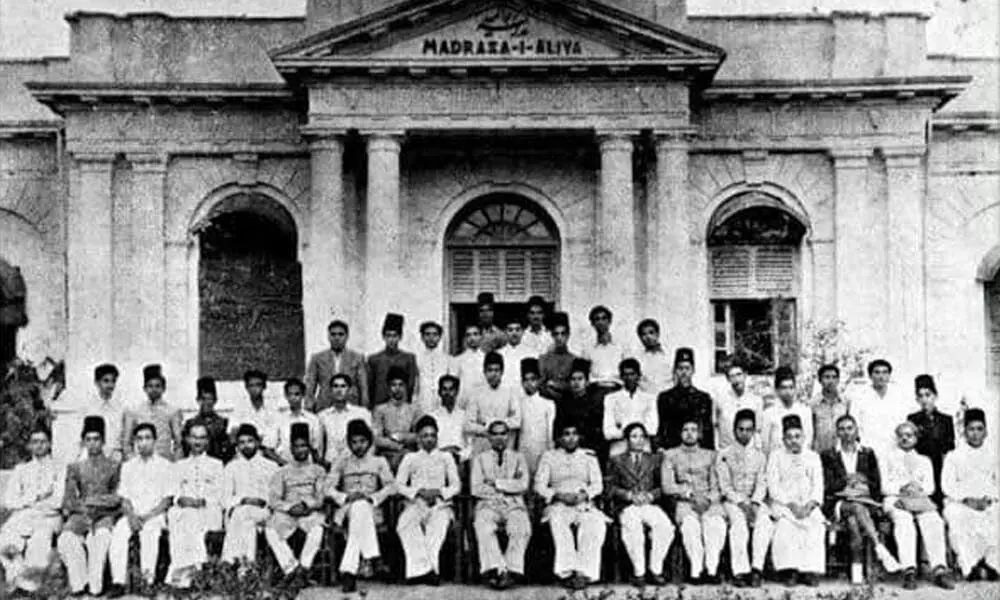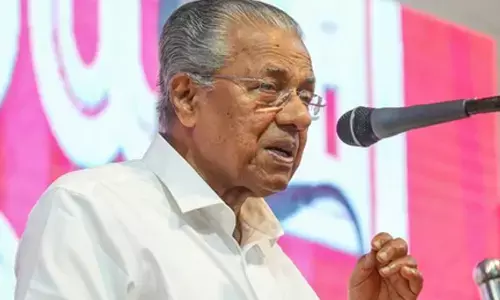Education in Hyderabad State during Nizam period

Education in Hyderabad State during Nizam period
The decline of the Mughal empire in India led to an internal disorder that paved the way for the European trading companies to interfere in local politics
The decline of the Mughal empire in India led to an internal disorder that paved the way for the European trading companies to interfere in local politics. Hyderabad State (Hyderabad Deccan) was no exception from it, where it lost Northern Circars because of the Carnatic wars and Ceded Districts because of its subsidiary alliance with the British. Hence, Circars and Ceded districts were ruled by the British as part Madras Presidency, which led to various vicissitudes in these areas such as administration, revenue, education and social policies. However, these developments were not materialized in the Hyderabad state.
The Census of the H E H The Nizam's Dominions 1901 revealed that the Hyderabad state was divided into four divisions namely, Medak-Gulshanabad, Warangal, Aurangabad, and Gulbarga. Each division was divided into districts and each district was subdivided into Taluks. The entire state was divided into 17 districts. Atraf-I-Balda, Nizamabad, Medak, Nalgonda, Mahabubnagar, Warangal, Karimnagar and Adilabad districts were part of Telangana region and Aurangabad, Nanded, Parbhani, Raichur, Lingsugur, Osmanabad, Bidar, Bhir and Gulbargha districts were part of Marathwada region.
Role of East India Company and missionaries in promoting education
Indigenous schools are found in the state, where the teacher focuses on reading, writing, and arithmetic. The teacher is paid in kind, whose income varies according to the size of the village and the importance given to education by its parents. Since the Nizam maintained good relationships with the English East India Company, the British Residency was established in Secunderabad and Christianity spread in few parts of Hyderabad state. The St. George's Grammar School, which was the first English Public school at Hyderabad city, was established in 1834 by the Church of England for the European children.
Later on, in 1839, the Resident set up a Medical school at Bolarum. Then, the Roman Catholic Mission started a school in Hyderabad in 1855, which was converted into the All Saints School to prepare secondary school teachers. Initially, the school was started to impart education to the children of the Nizam's Army staff and later on admitted children of all castes. Missionaries were established in English medium schools in Hyderabad city, Aurangabad, Warangal, and Gulbarga. They include general, technical, and professional schools. Western education gained importance due to the recruitment of non-mulkis (non-locals) in administration from Aligarh, Madras, Bombay, Bengal, etc. especially under Salar Jung-I.
The response of the State to societal needs
A Madrassa was started at the Juma Masjid in Hyderabad city in 1830. Later on, in 1859, the State of Hyderabad decided to open two schools in every Taluk and three schools in every district. Persian and vernacular schools were opened in Taluks whereas Persian, English, and vernacular schools were opened at district headquarters. Monthly fees in Taluk and District schools were one anna (6.25 paise) and two annas respectively. However, the children who belong to the agricultural class were exempted from paying fees. The City High School and the Chaderghat High School were established in 1870 and 1872 respectively. The School of Engineering was established in 1870 to train technical personnel that requires for the public works department. The state was appointed a Director of Vernacular Education in 1871 to improve the system of District schools. However, the management of education was under the control of the revenue department.
About 125 vernacular schools were run by the state in all the districts in 1872. Besides, 16 schools functioned in the same year in Hyderabad city and suburbs, in which one school taught English. In 1875, the management of education transferred to the Department of Public Instruction by appointing five Deputy Inspectors. An Anglo-vernacular school was started for the first time in Aurangabad during the same period. Madrasa-i-Aliya was established for the children of the nobles and Madrasa-i-Aizza was opened for the children of the Royal family in 1873 and 1878 respectively under private management with English teachers. The state made compulsory payment of fees in the District schools in the year of 1878.
The City English High School and the Chaderghat High School were merged in 1877. The Chaderghat high school was affiliated to the Madras University as a second-grade college in 1880. Eventually, the Nizam College was established in 1887 by merging the intermediate classes of the Chaderghat High School with Madrasa-e-Aliya. Darul-ulum/Oriental College was established in 1854 at Hyderabad city with Arabic and Persian as a medium of instruction. Physics, Chemistry, Mathematics, and Astronomy were taught as part of the curriculum. The first City English medium High School was opened in 1857, where English, Arabic, Persian, Hindustani, Telugu, Marathi, and Kanarese were taught.
Even the Nizam was to speak only in English during breakfast and dinner on every Monday and Thursday, where the English tutor was present and for any breach of rule the companions were fined. Laiq Ali, son of Salar Jung-I, who was English educated man appointed as Diwan in 1883 to westernise and modernise the State.
Religious Education: A demand from the community
The Madrassa-i-Deeniya was started in 1882 to impart religious training to Muslim youth. A Sanskrit school called the Vedic Dharma Prakashika started at Hyderabad in 1894 to impart religious training to Hindu boys. Another Sanskrit school, which was aided by the state established at Hyderabad in 1899. Dharmwant High School and Mufeedul-Anam High School were the first two private schools that inculcated western education with English medium in the old city, which were founded by the Malwala Kayasth family and the leaders of the Khatri caste in 1880 and 1882 respectively.
Asafia High School was established in 1895 to impart both secular and moral education among Muslim children. The Vivek Vardhini Pathasala, which was the first private Marathi school founded in Hyderabad in 1901 whereas the first Telugu school was started by Ranga Rao Kaloji in Chaderghat in 1904. The Anwar Uloom High School was founded by Moulvi Muhammed Abdul Razzak in 1909.
Role of the State in promoting girls' education
The unwillingness of Muslims to send their daughters to schools, early marriages among Hindus, and the absence of trained women teachers were the main barriers to the progress of female education during the Nizam period. The first government Zenana school was opened during the period of Nizam-VI. Dr. Aghoranath Chattopadhyaya started a Hindu Anglo-vernacular school in 1877 to educate both Muslim and Hindu girls. The Wesleyan Mission started girls' schools at Secunderabad and Chaderghat in 1882. Syed Hussain Bilgrami established a school for Muslim girls in 1885 with qualified staff. Needlework, domestic science, Arabic, Persian, and English were taught to girls as part of the curriculum.
An institution for girls was opened at Bolaram during the 1880s. The Mufeedul-Anam High School started a primary section for girls during the 1890s. The Nampally Girls' School was established in 1890, which was the first government middle school for girls in Hyderabad state. The Stanley Girls' School was started in 1895. Later on, it upgraded as a High School in 1908 and four girls appeared for the school-leaving examination in 1911. The Telugu Normal School and Elizabeth Stanley Girls' High School, which are located in Hyderabad imparted training to Telugu teachers. The state granted stipends to the students and appointed bullock carts for their conveyance to and from the school.
The question of language in education
The Nizam government made compulsory proficiency in Persian or Urdu for Hindu students to go to England for higher studies. In this way, the Hindus of the Hyderabad State faced cultural humiliations and political inequality. Hence, the Arya Samaj established in Hyderabad in 1892 to protect the rights of the Hindus. The state promoted Urdu as the official language in administration by neglecting other languages such as Telugu, Marathi, and Kannada that were spoken by the majority of people (approximately 86 per cent) in Hyderabad state. Besides, the Nizam directed that state-aided education was given only through Urdu or English. Even the primary objective of Osmania University was to provide higher education for only Muslim students. Moreover, the government did not allow private institutions to impart education in the language of the people.
Several activists worked though organizations for the promotion of Telugu in the Telangana region during the Nizam rule. Kommaraju Lakshmana Rao established 'Sri Krishnadevaraya Andhra Basha Nilayam' at Hyderabad in 1901. Two Telugu libraries namely 'Sri Rajaraja Andhra Basha Nilayam' and 'Andhra Samvardhini Grandhalayam' were established in 1904 and 1905 at Hanumakonda and Secunderabad respectively. The Arya Samaj played a vital role in establishing Vivek Vardini Pathasala to impart education through Marathi and English. Subsequently, the Vignana Chandrika Grandha Mandali at Hyderabad published popular literature in Telugu.
Besides, the contributions of renowned personalities for promoting education are marvellous and cherished forever. Bilgarmi took the initiation to establish three industrial schools in Hyderabad, Aurangabad, and Warangal as well as the State Central Library in Hyderabad. Raja Bahadur Venkat Ram Reddy was instrumental to establish Narayanguda Girls' High School (renamed as Madapati Hanumantha Rao School) in 1928 and separate hostels for boys and girls belong to Reddy community in 1918 and 1933 respectively. Bhagya Reddy Varma not only fought for establishing schools for the children of most marginalized sections but also established few schools for Dalit children in Hyderabad city.
According to the Census of the H E H the Nizam's Dominions 1921, the general and English literacy rate of Hyderabad State were only 3.3 and 0.3 respectively. If we compare with other provinces and states, it stands last both in general education and in literacy in English. The census reported that general literacy rate among Hindus (2.6), Muslims (8.9), Christians (25.2) and Animist (0.8) whereas English literacy rate among Hindus (0.2), Muslims (0.9) and Christians (16.1). The total literacy rate in the Telangana region is 4.2 whereas the total literacy rate of the Marathwada region is 2.4. Though the Nizam state accepted modern education, it was the language policy and lack of state commitment led to the educational backwardness in Hyderabad state during the Nizam rule compared to other princely states and British India.
(The authors are Assistant Professor, Loyola Academy Degree & PG College, Secunderabad and Professor, Department of Sociology, University of Hyderabad.)













